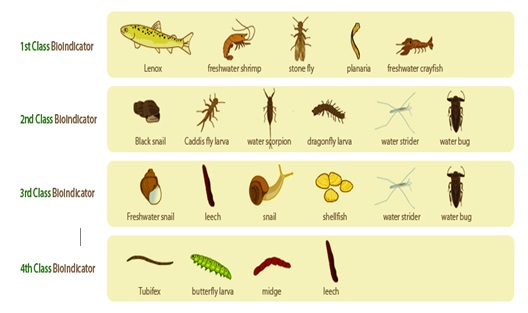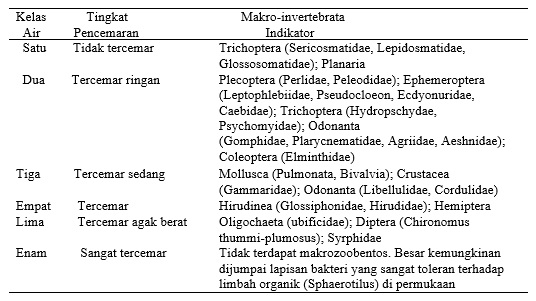Water Strider (Gerris marginatus) as a Bioindicator of Pollution in Fresh Water
23/12/2022 Views : 1002
I K. Putra Juliantara
Monitoring changes in the aquatic environment can be detected by utilizing a bioindicator, living things that act as biological indicators of the quality of an environment. Its appearance can be used as an indicator of resources in its habitat which can describe the past, present and future ecological situation of the environment (Private, 2003; Kopciuch et al., 2004; Sudarso, 2009; Bellinger and Sigee, 2010; Samways et al. , 2010).
Some guidelines that can be used as a reference for ecological bioindicators are steno species (narrow tolerance limit for environmental factors) which are better used as indicators than eury species (wide tolerance limits for environmental factors), mature species are better used as indicators than young species. , as well as the existence of factors that are actually limiting factors before deciding a species can be used as a bioindicator (Odum, 1993). If using a single species as a bioindicator, the characteristics of the species must have a rapid response to environmental changes, be a shorthand species, have a known taxonomy, be reliable identification, and have a wide geographical distribution (Bellinger and Sigee, 2010).
The various bioindicator species can be grouped into five: first, sentinel species, which are species that have a high sensitivity to pollutants, where these species are generally introduced to a habitat to detect and provide early warning of pollution. Second, detector species, namely species native to a habitat that are able to show measurable changes (eg changes in behavior, mortality, morphology) under changed environmental conditions. Third, exploiter species, namely these species exist in a polluted environment with an abundance of individuals as a result of a lack of competition with other species that are unable to adapt. Fourth, accumulator species, namely species that take and accumulate chemical compounds whose amount can be measured. Finally, bioassay species are species that can be used as laboratory tests, for example to test the presence and concentration of a pollutant, as well as to rank the level of toxicity of a pollutant (Spellerberg, 2005; Samways et al., 2010).
Some examples of the use of living things as bioindicators include: lichens which are used as bioindicators of air pollution (Wolterbeek et al., 2003; Das et al., 2011); utilization of Hydra, plankton, macro-invertebrates, and macro-zoobenthos to determine water quality (Handayani et al., 2001; Sekiranda et al., 2004; Suwondo et al., 2004; Setiawan, 2009; Huarachi and Gonzales, 2012); algae are used to identify the eutrophic status of a waters (Dokulil, 2003; Bellinger and Sigee, 2010); and birds as bioindicators of chemical pollution accumulators and climate change (Becker, 2003; Dzugan, 2012).
The most efficient organisms used as bioindicators in fresh water bodies are benthic macro-invertebrates (macro-zoobenthos). This is due to its abundant presence from upstream to downstream, easy to collect and identify, relatively long-term sedentary life in various water conditions, limited mobility and related to habitat preferences (Wardhana, 1999; Handayani et al., 2001; Suwondo et al., 2004; Tjokrokusumo, 2006; Wijayanti, 2007).
Most researchers use macro-invertebrates as bioindicators of pollution in fresh water bodies (Handayani et al., 2001; Sekiranda et al., 2004; Suwondo et al., 2004; Tjokrokusumo, 2006; Yimer and Mengistou, 2009). Some of the advantages of macro-invertebrates such as insects, worms, snails and crustaceans as bioindicators are the abundance of these animals is quite high in nature, their distribution is limited, they do not require special tools, their life cycle is short (≤ 1 year), and they are easy to observe (Tjokrokusumo, 2006) .
There are several advantages in using insects to monitor changes in the aquatic environment, including: high abundance, play an important role in aquatic ecosystems, are not constrained by ethical codes in sampling, are suitable for habitat monitoring, are more economical than other bioindicators because they can be monitored using passive trap sampling methods , identification of aquatic insects is quite easy, and easy to detect and predict their response to environmental changes (Shahabuddin, 2004; Gullan and Cranston, 2005).
Some of the advantages of using bioindicators compared to physical and chemical parameters in monitoring changes in the quality of the aquatic environment are that they reflect the overall water quality (integration of the impact of various environmental factors over time), provide a direct measure of ecological impact, and provide information that is reliable, fast, and inexpensive to record conditions throughout the aquatic environment (Bellinger and Sigee, 2010). The benefits of bio-indicators include: as a detector of environmental change, can be used as a measure or model to characterize the quality of an ecosystem, as a method for monitoring the negative impact of industrial activities on the environment, as well as playing a role in sustainable development so as to ensure the industry has the least possible impact on the environment (Sauvolic et al., 2007).
Bioindicators for a certain class of water can be seen in Figure 1 below. Several aquatic insects that can be used as bioindicators include stone flies, caddis fly larvae, dragonfly larvae, water bugs, water strider, and butterfly larvae (Ministry of Environment Republic of Korea, 2010).

Figure 1. Classification of Water Class and its Bioindicators (Ministry of Environment Republic of Korea, 2010)
Evaluation of fresh water quality can be carried out with reference to water class standards and bioindicators as shown in Figure 1. In Figure 1, it is shown that water strider are bioindicators in class two and three water. Second class water is water that can be used for bathing, swimming and drinking after going through a certain process. In class two water, bioindicators that can be used are black snails, caddis fly larvae, water scorpions, dragonfly larvae, water strider, and water bugs. If you find these bioindicators in an abundance of fresh waters, then the water in these fresh waters is included in the second class of water.
Third class water is water that is muddy with a yellowish brown color. In class three water, bioindicators that can be used are freshwater snails, leeches, snails, shellfish, water strider, and water bugs. If you find these bioindicators in an abundance of fresh waters, then the water in these fresh waters is classified as class three water.
The grouping of macro-invertebrates for assessing water quality in fresh water bodies, especially rivers, can be seen in Table 1. In Table 1, the grouping of macro-invertebrates is based on the highest abundance found at certain water quality levels.
Table 1. Grouping of Macro-Invertebrates for Assessing Water Quality (Wardhana, 1999)

Based on Table 1, river water is classified as not polluted, if there are Trichoptera (Sericosmatidae, Lepidosmatidae, Glossosomatidae) and/or Planaria, accompanied by the absence of indicator species found in class two to six water. River water is classified (slightly polluted, moderately polluted, polluted, slightly polluted and highly polluted), if there is one or a mixture of macro-invertebrates in each water class group.
If the macro-invertebrates found consist of a mixture of different water classes, then there are certain conditions. River water is categorized as slightly polluted, if there is a mixture of macro-invertebrates from class one and two, or class one, two and three. River water is categorized as lightly polluted, if there is a mixture of macro-invertebrates from class two and three, or from class two, three and four. River water is categorized as polluted if there is a mixture of macro-invertebrates from class three and four, or from class three, four and five. And river water is categorized as highly polluted, if there is a mixture of macro-invertebrates from class four and five water. Based on Table 1, water strider including Hemiptera can be used as bioindicators in polluted fresh water bodies (class four water).
References
Becker, P.H. 2003. Biomonitoring with Birds. In: Markert,B.A., Breure, A.M., Zechmeister, H.H., editors. Bioindicators & Biomonitors: Principles, Concepts and Applications. UK: Elseiver Science Ltd.
Bellinger, E.G., and D.C. Sigee. 2010. Fresh Water Algae: Identification and Use as Bioindicators. UK: John Willey & Sons, Ltd.
Das, K., Dey, U., Bhaumik, R., Datta, J.K., Mondal, N.K. 2011. A Comparative Study of Lichen Biochemistry and Air Pollution Status of Urban, Semi Urban, and Industrial Area of Hooghly and Burdwan District, West Bengal. Journal of Stress Physiology & Biochemistry, 7 (4): 311-323.
Dokulil, M.T. 2003. Algae as Ecological Bio-Indicators. In: Markert,B.A., Breure, A.M., Zechmeister, H.H., editors. Bioindicators & Biomonitors: Principles, Concepts and Applications. UK: Elseiver Science Ltd.
Dzugan, M., S. Zielinska, J. Heclik, M. Pieniqzek. 2012. Evaluation of Heavy Metals Environmental Contamination Based on Their Concentration in Tissue of Wild Pheasant (Phasianus colchicus L.). Journal of Microbiology, Biotechnology, and Food Sciences, 2 (1): 238-245.
Gullan, P.J., and P.S. Cranston. 2005. The Insect: An Outline of Entomology. UK: Blackwell Publishing Ltd.
Handayani, S.T., B. Suharto, Marsoedi. 2001. Penentuan Status Kualitas Perairan Sungai Brantas Hulu dengan Biomonitoring Makrozoobentos; Tinjauan dari Pencemaran Bahan Organik. Jurnal Biosain, 1 (1): 30-38.
Huarachi, R., and R. Gonzales. 2012. Hydra vulgaris pallas (Hydrozoa:Hydridae) as Bioindicator of The Water Quality of The River Chili, Arequipa, Peru. The Journal of Biologist, 10 (2) : 125-137.
Kopciuch,G., B. Berecka, J. Bartoszewicz, B. Buszewski. 2004. Some Considerations About Bioindicators in Environmental Monitoring. Polish Journal of Environmental Studies (PJES), 13 (5): 453-462.
Ministry of Environment Republic of Korea. 2010. Indicator Organisme Tells the Health of Rivers. (serial online), [cited 2010 Mei 6]. Available from: http://eng.me.go.kr/content.do?method=moveContent&menuCode=res_kid_wat_abo_organisme.
Samways, M.J., M.A. McGeoch, T.R. New. 2010. Insect Conservation; A Handbook of Approaches and Methods. New York: Oxford University Press Inc.
Sauvolic, D., R. Biocanin, B. Rodriquez. 2007. Serbia: Bioindicators in Human Environment.
Sekiranda, S.B.K., J. O. Okumu, F.W.B. Bugenyi, L.M. Ndawula, P. Gandhi. 2004. Variation in Composition of Macro-Benthic Invertebrates as an Indication of Water Quality Status in Three Bays in Lake Victoria. Uganda Journal of Agricultural Science, 9 : 396-411.
Setiawan, D. 2009. Studi Komunitas Makrozoobenthos di Perairan Hilir Sungai Lematang Sekitar Daerah Pasar bawah Kabupaten Lahat. Jurnal Penelitian Sains, 9: 67-72.
Shahabuddin. 2004. Potensi dan Metode Penggunaan Serangga Sebagai Bioindikator Kesehatan Hutan (Potential and Methods of Using Insects as Bioindicator of Forest Health). IPB: Program Doktoral Entomologi Pertanian.
Spellerberg, I.F. 2005. Monitoring Ecological Change. UK: Cambridge University Press.
Suwondo., E. Febrita, Dessy, M. Alpusari. 2004. Kualitas Biologi Perairan Sungai Senapelan , Sago, dan Sail di Kota Pekanbaru Berdasarkan Bioindikator Plankton dan Bentos. Jurnal Biogenesis, 1(1): 15-20.
Swasta, I. B.J. 2003. Diktat Ekologi Hewan. Singaraja: Jurdik Biologi Undiksha.
Tjokrokusumo, S.W. 2006. Bentik Makro-invertebrata sebagai Bioindikator Polusi Lahan Perairan. Jurnal Hidrosfir, 1(1): 8-20.
Wardhana, W. 1999. Perubahan Lingkungan Perairan dan Pengaruhnya terhadap Biota Akuatik. Depok: Jurusan Biologi Universitas Indonesia.
Wijayanti, H. 2007. “Kajian Kualitas Perairan di Pantai Kota Bandar Lampung Berdasarkan Komunitas Hewan Makrobenthos” (tesis). Semarang: Universitas Diponegoro.
Wolterbeek, H.T., J. Garty, M.A. Reis, M.C. Freitas. 2003. Biomonitors in Use: Lichens and Metal Air Poluttion. . In: Markert,B.A., Breure, A.M., Zechmeister, H.H., editors. Bioindicators & Biomonitors: Principles, Concepts and Applications. UK: Elseiver Science Ltd.
Yimer, H.D., S. Mengistou. 2009. Water Quality Parameters and Macroinvertebrates Index of Biotic Integrity of The Jimma Wetlands, Southwestern Ethiopia. Journal of Wetland Ecology, 3: 77-93.
